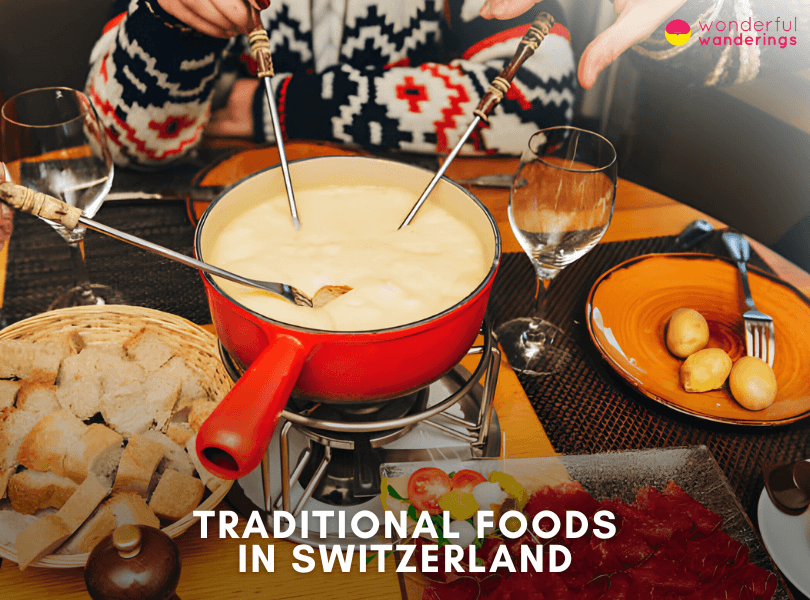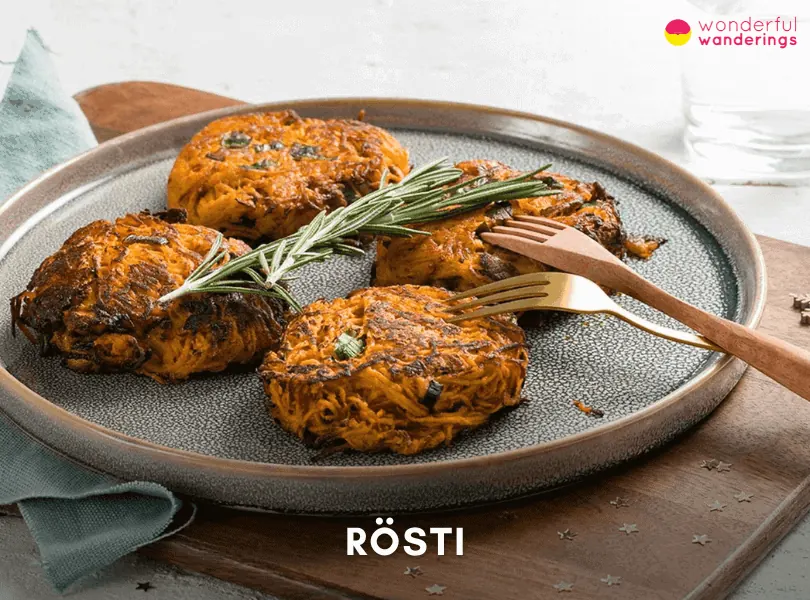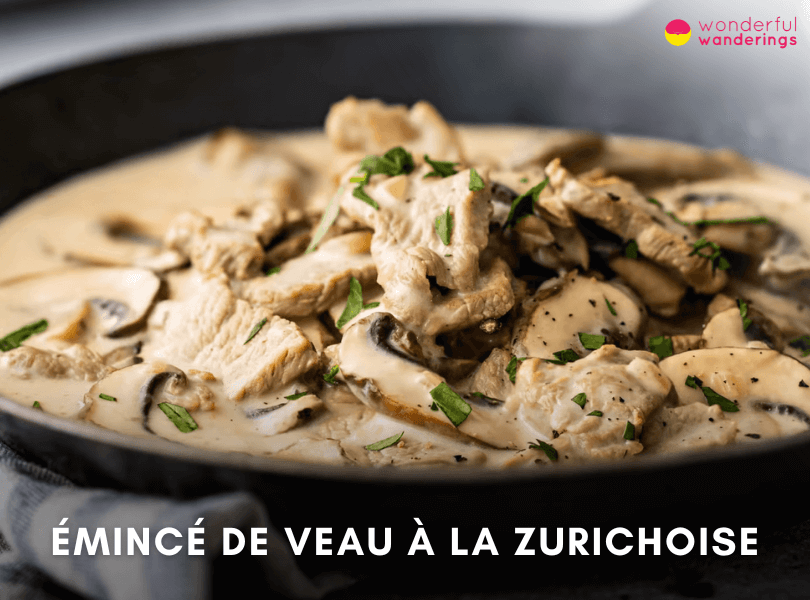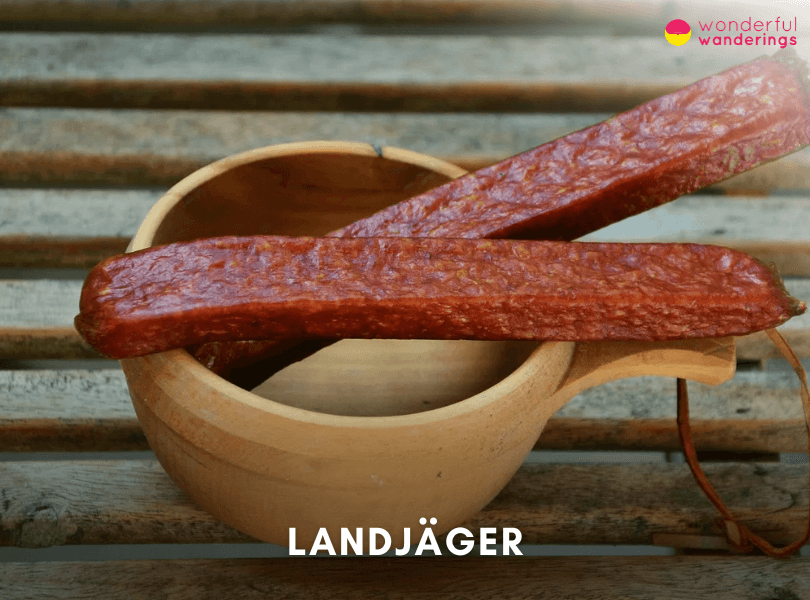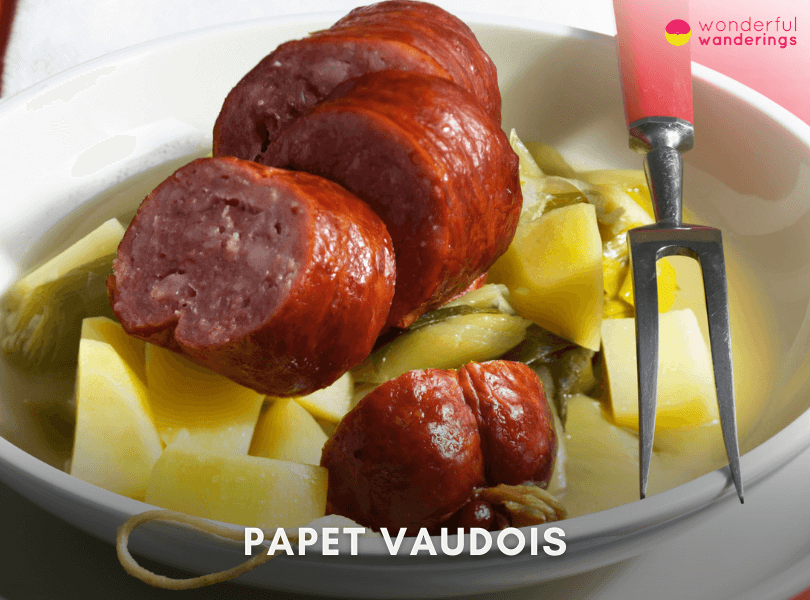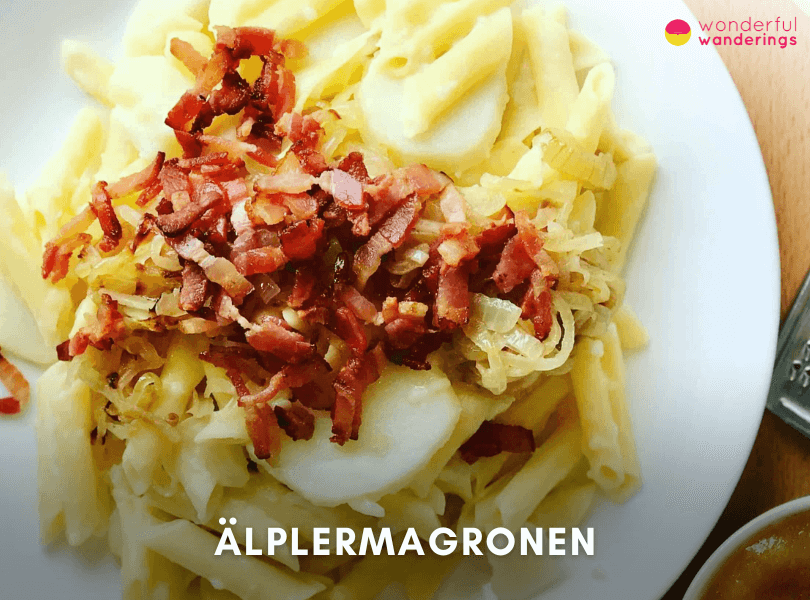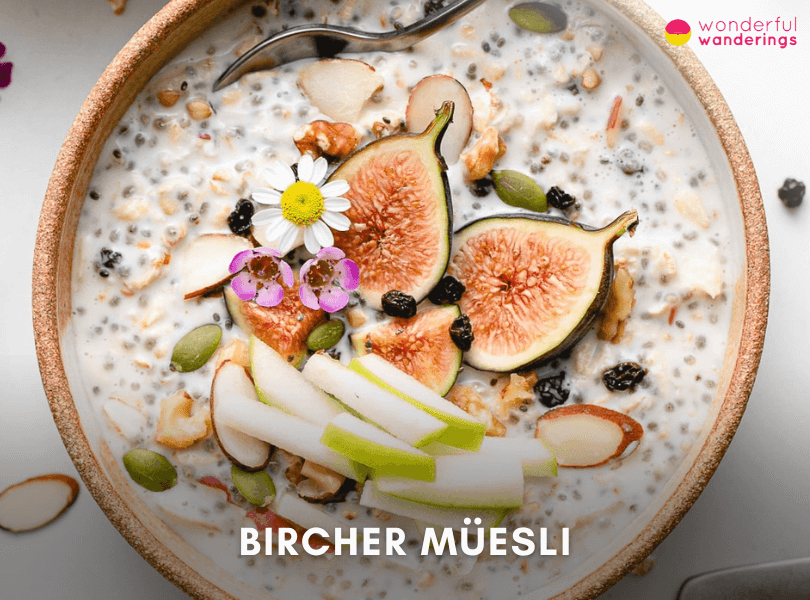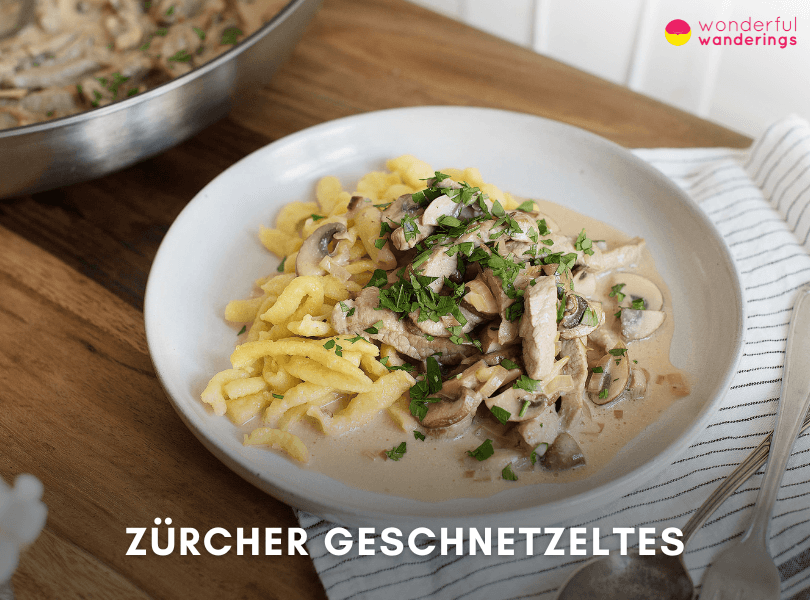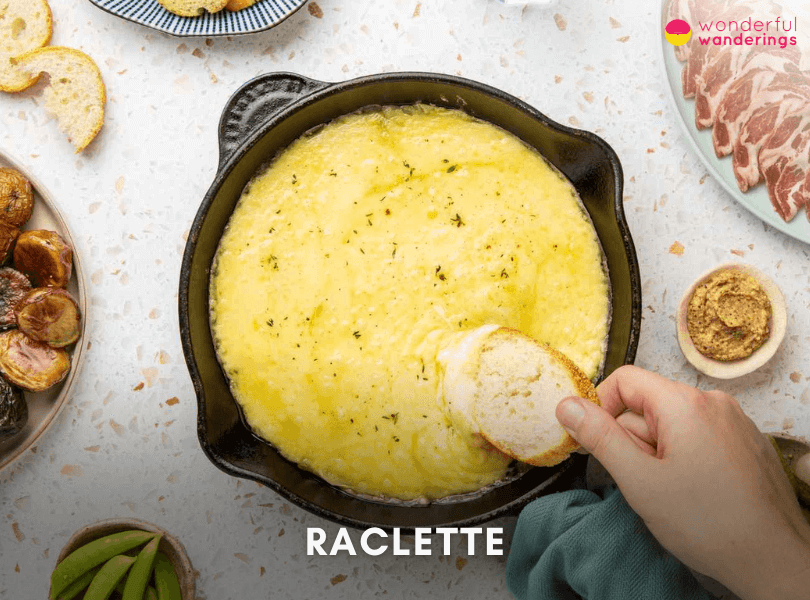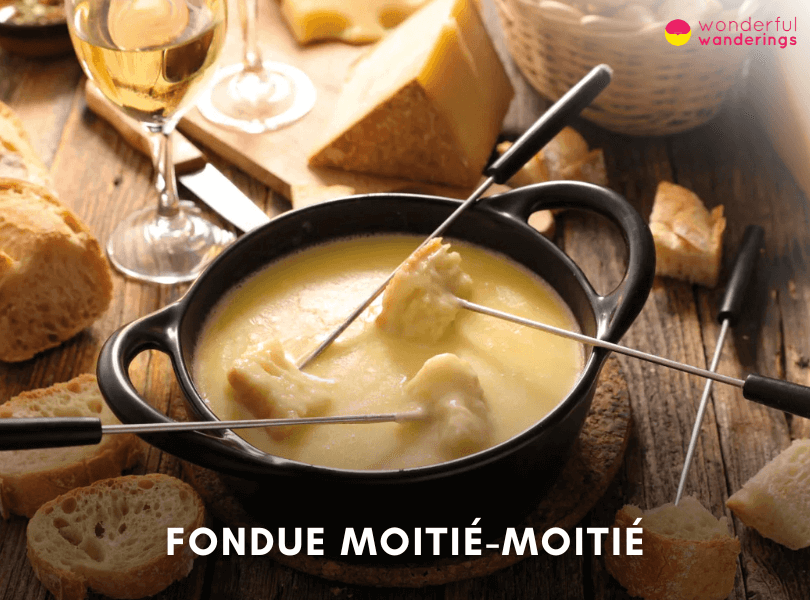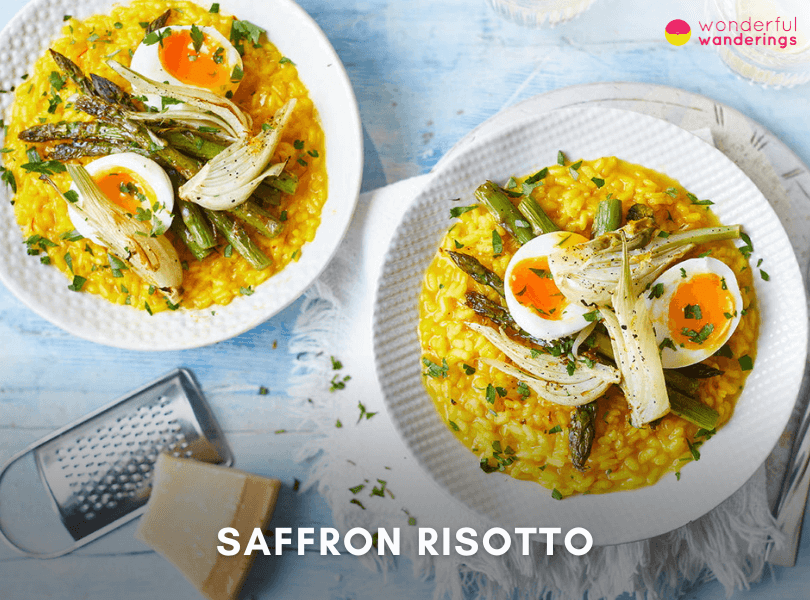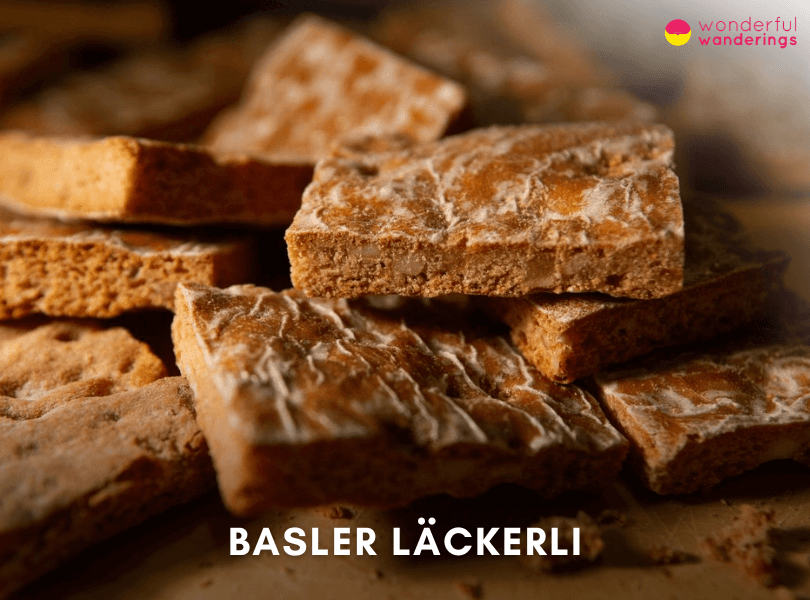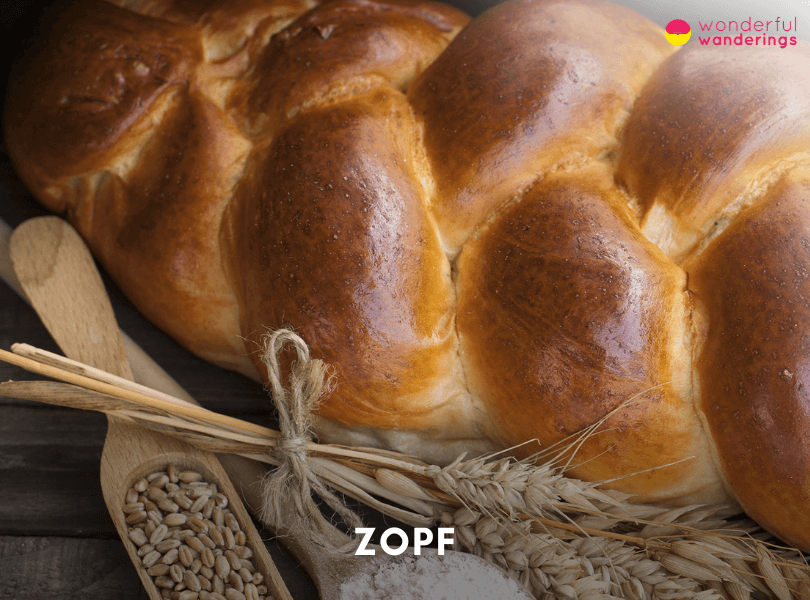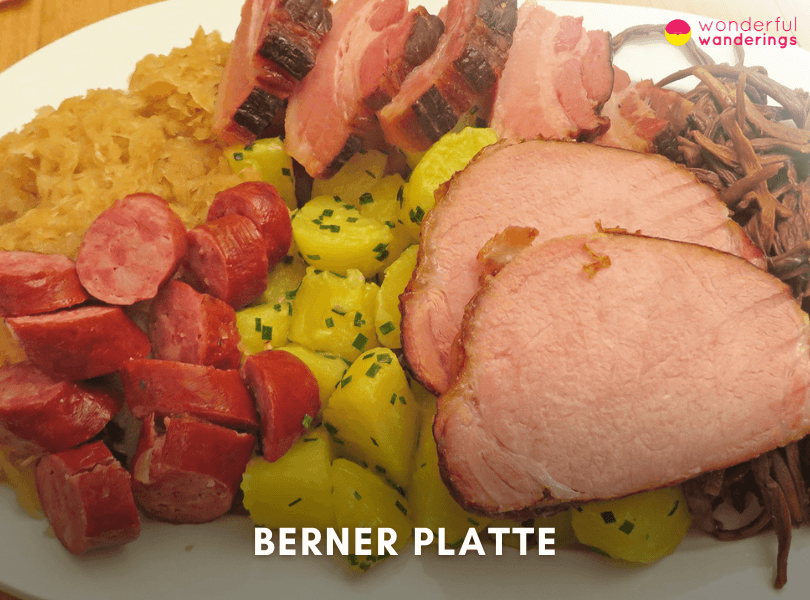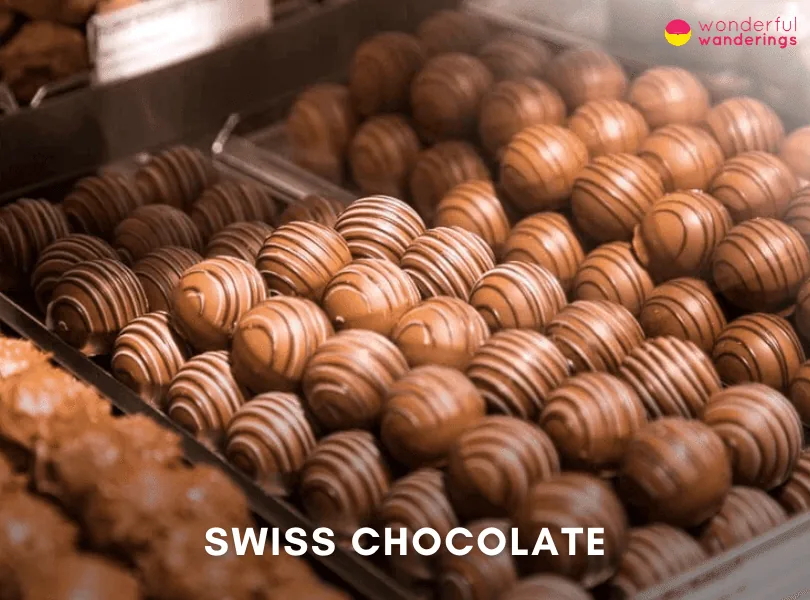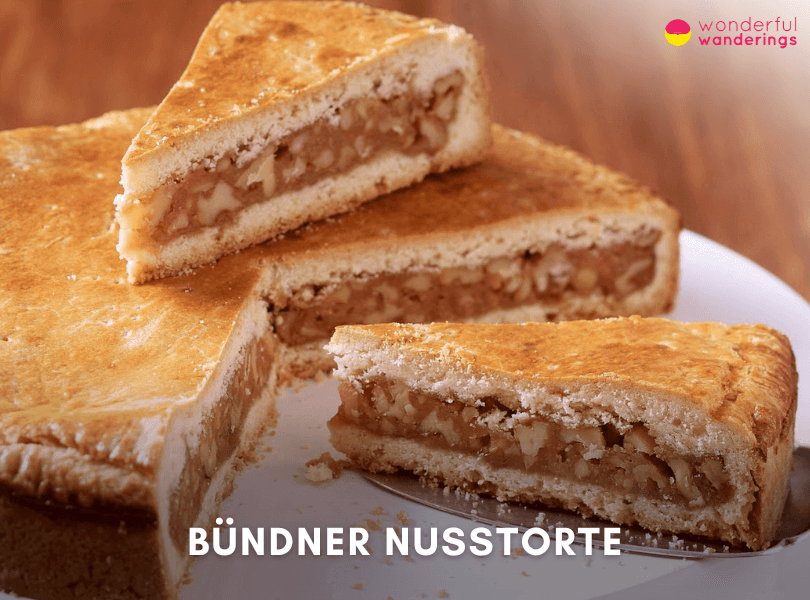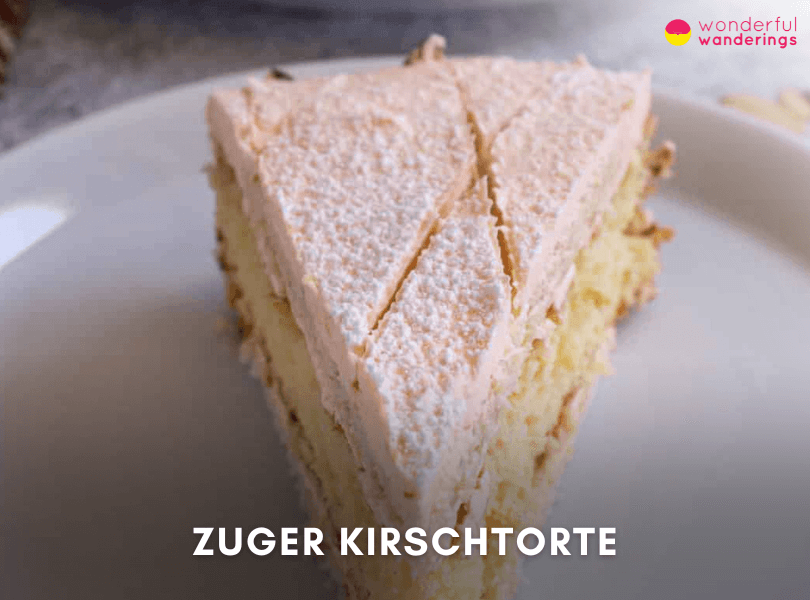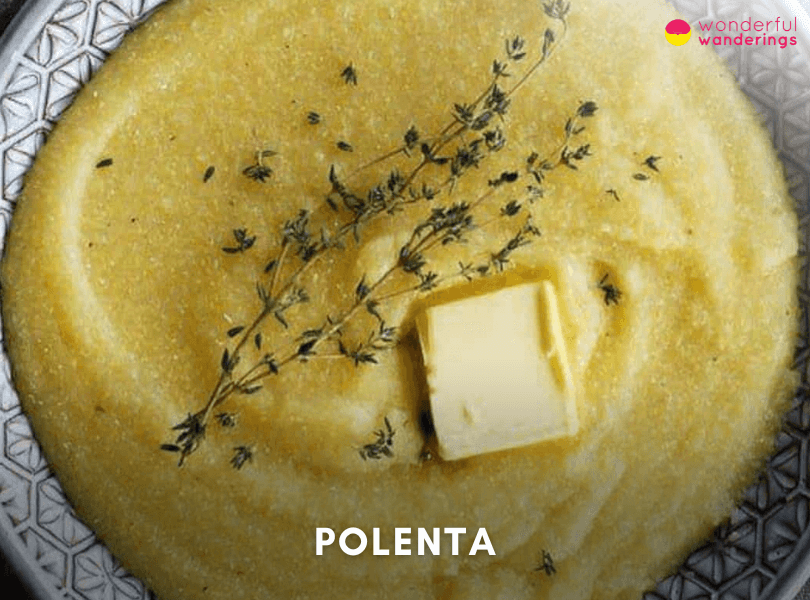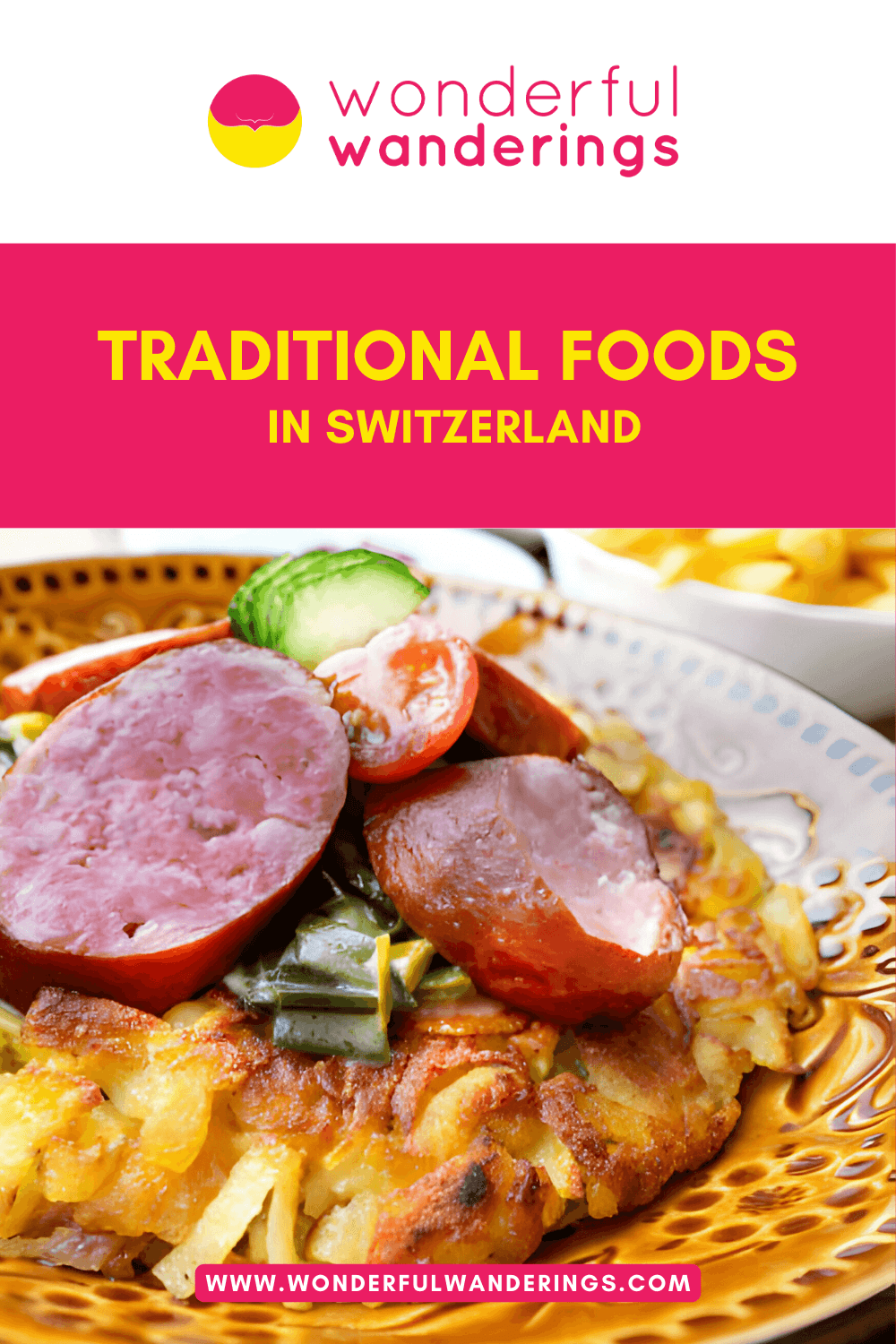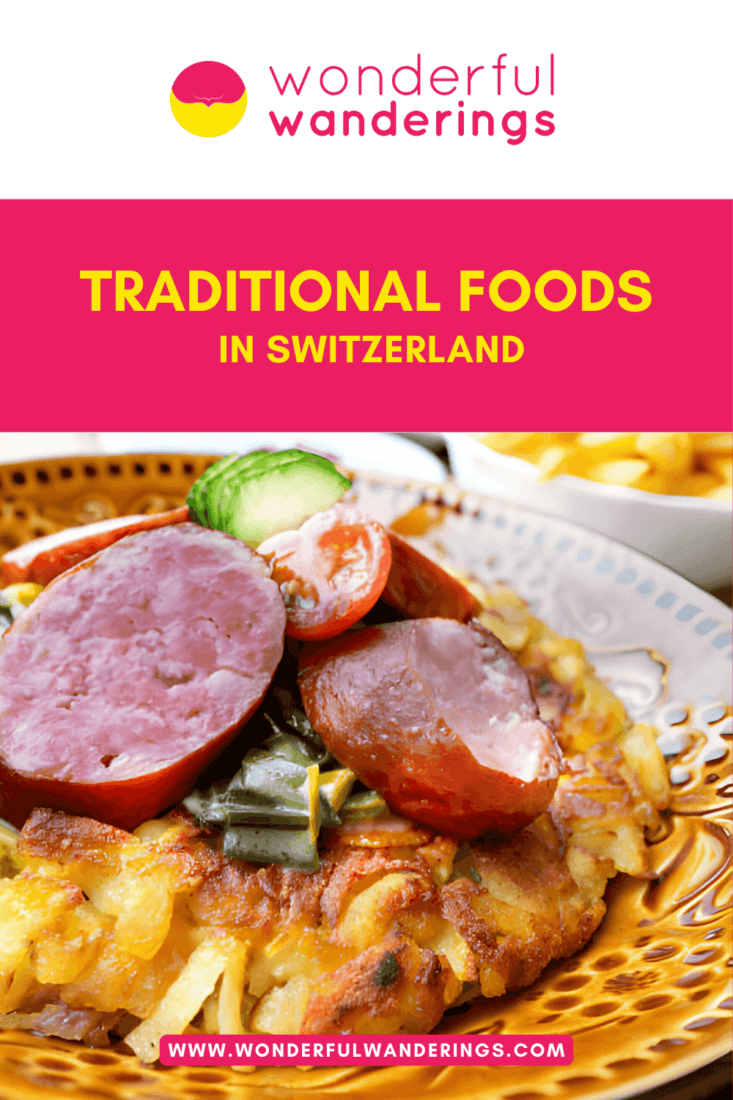Swiss cuisine is diverse and rich, shaped by the country’s French, German and Italian influences. Several signature dishes represent Switzerland’s culinary heritage. Visitors can experience authentic Swiss specialties in Bern, like cheese fondue, melted cheese dish with bread for dipping and raclette, melted cheese served with potatoes and pickles. Other Swiss specialties found in Switzerland include rösti (hashbrown potato pancakes), landjäger (dried sausage), bircher muesli (oat and fruit cereal) and rich chocolate creations. The Swiss locale of Bern on the shores of Lake Bern provides the perfect backdrop to savor Swiss delicacies like papet vaudois, a potato and leek dish, älplermagronen, a hearty alpine macaroni with cheese and potatoes and zuger kirschtorte, a cherry-kirsch cake. Sampling these traditional foods offers insight into Switzerland’s diverse culinary heritage.
Listed below are traditional Swiss foods.
- Rösti. Rösti is a traditional Swiss dish made of grated and fried potatoes, similar to a hashbrown or potato pancake. It is a versatile side dish served for breakfast with fried eggs or accompaniment to meat dishes for lunch and dinner. Rösti is commonly enjoyed in Switzerland and found in Bern at authentic Swiss cuisine restaurants.
- Émincé de veau à la Zurichoise. Émincé de veau à la Zurichoise is a traditional Swiss veal dish made with thinly sliced veal in a creamy mushroom and white wine sauce. It is served with rösti, making it a hearty and flavorful meal. The dish can be found in Bern at restaurants known for Swiss cuisine and combines the tender veal with the creamy sauce and crispy rösti potato pancake.
- Landjäger. Landjäger is a Swiss semi-dried sausage made from beef, pork, wine and spices. It is a convenient protein-rich snack often taken by hunters and hikers. Landjäger can be found in Bern at specialty food shops and markets. It is frequently served as part of a Swiss snack platter alongside bread, cheese and pickles.
- Papet Vaudois. Papet Vaudois is a comforting one-pot dish from the Vaud canton made with leeks, potatoes and smoked sausage. It is known for its creamy texture and is often served during winter. Papet Vaudois can be found in Bern at restaurants specializing in Swiss cuisine.
- Älplermagronen. Älplermagronen is a hearty Swiss dish combining macaroni, potatoes, cheese, onions and often apple sauce. It is a popular comfort food in Alpine regions, providing sustenance after outdoor activities. The cheese and apple sauce create a balanced flavor profile.
- Bircher Muesli. Bircher muesli is a classic Swiss breakfast dish containing oats, fruit, nuts, seeds and dairy/milk. It is soaked overnight to achieve a creamy texture. Bircher muesli is served for a healthy breakfast and can be customized for different diets.
- Zürcher Geschnetzeltes. Zürcher Geschnetzeltes is a thinly sliced veal served in a creamy mushroom sauce, often accompanied by Rösti potatoes. It is a popular Swiss main course and provides a hearty flavor but can be high in calories due to the cream content. It is enjoyed for its tender veal paired with the creamy mushroom sauce.
- Raclette. Raclette involves heating raclette cheese and scraping the melted part over boiled potatoes, pickles and onions. It is a Swiss dish enjoyed in restaurants and homes for hours. The melted cheese is paired with the side accompaniments to create a well-balanced meal.
1. Rösti
Rösti or Röschti, is a traditional Swiss dish with coarsely grated and fried potatoes. It is a versatile dish that can be served as a side to accompany other meals, such as with eggs for breakfast or alongside meat dishes for lunch or dinner. Rösti is best served in Switzerland as a side dish to accompany various meals. It is enjoyed with fried eggs for breakfast or as a complement to meat dishes such as sausages, schnitzel or thinly sliced veal in cream sauce. The crispy and savory nature of Rösti makes it a popular addition to many Swiss meals.
Visitors to Bern can try Rösti at restaurants known for authentic Swiss cuisine. The healthiness of Rösti can vary depending on factors such as the cooking method and additional ingredients. The frying process of potatoes can increase the dish’s calorie and fat content. Variation dishes of Rösti include adding ingredients such as cheese, onions or fresh herbs to the grated potatoes before frying. In some regions, other vegetables or fruits are used to create different versions of this classic dish. The perfect sauces to match with Rösti include traditional Swiss accompaniments such as apple sauce or sour cream. These sauces complement the crispy texture and savory flavor of the Rösti. The ingredients needed to cook Rösti include white potatoes, butter or cooking oil, salt and pepper. Additional ingredients for variations may include cheese, onions or herbs.
2. Émincé de Veau à la Zurichoise
Émincé de veau à la Zurichoise, also known as Zürcher Geschnetzeltes, is a traditional Swiss dish made of thinly sliced veal in a creamy mushroom and white wine sauce. It is typically served with rösti, a Swiss potato dish, making it a flavorful and hearty meal. This dish is best served in Switzerland with rösti, a classic accompaniment to Zürcher Geschnetzeltes. Rösti is a Swiss dish made of grated and fried potatoes, similar to a hash brown. Combining the tender veal and creamy sauce with the crispy rösti makes for a delicious and satisfying meal.
Visitors to Bern can enjoy Émincé de veau à la Zurichoise at various traditional Swiss restaurants. The healthiness of Émincé de veau à la Zurichoise depends on its ingredients and preparation. Veal is a good source of protein and various nutrients, but the dish’s cream and butter content may make it high in saturated fat and calories. Variations of this dish include using different types of meat, such as chicken or pork, instead of veal. The choice of herbs and spices can create different flavor profiles. Some recipes also incorporate onions or shallots for added depth of flavor. The perfect sauces to match with Émincé de veau à la Zurichoise are creamy mushroom-based sauces with white wine. The traditional creamy mushroom and white wine sauce accompanying the veal perfectly match this dish. The ingredients needed to cook Émincé de veau à la Zurichoise include veal, butter or cooking cream, onion, mushrooms, flour, white wine, lemon zest, salt, pepper and parsley.
3. Landjäger
Landjäger is a semi-dried sausage originating from Switzerland. It is a popular snack sausage made from beef, pork, lard, sugar, red wine and various seasonings. The name “Landjäger” translates to “country hunter” in English, reflecting its historical association with being a convenient and durable food for hunters and travelers. Landjäger is best served in Switzerland as a portable snack for outdoor activities such as hiking, camping or picnicking. Its semi-dried nature makes it a convenient, long-lasting protein source for on-the-go consumption. It is enjoyed as part of a traditional Swiss snack platter, often paired with cheese, bread and pickles.
Visitors to Bern can find Landjäger at local markets, specialty food stores and butcheries. It is offered at some traditional Swiss restaurants and cafes as part of a snack platter or as a standalone item. The healthiness of Landjäger can vary based on its ingredients and nutritional content. It may be high in saturated fat and sodium as a processed meat product and can also be a good source of protein. It is important to consume Landjäger in moderation as part of a balanced diet. Variation dishes of Landjäger include different flavor profiles achieved by adjusting the seasonings and spices used in the sausage mixture. Some variations may also incorporate additional ingredients, such as cheese or herbs, to create unique twists on the traditional recipe. Landjäger is enjoyed as a snack and does not require a specific sauce for serving. It can be paired with traditional Swiss condiments such as mustard or horseradish for added flavor. The ingredients needed to make Landjäger include beef, pork, lard, sugar, red wine, salt, pepper, garlic, coriander and other seasonings. The mixture is stuffed into natural casings and then semi-dried to achieve the characteristic texture and flavor of Landjäger.
4. Papet Vaudois
Papet Vaudois is a traditional Swiss dish from the Vaud canton. It is a comforting and hearty one-pot meal made with leeks, potatoes, sausages and the Vaud smoked pork (and beef) sausage. The dish is known for its creamy and tender leeks and potatoes served with Vaud sausage. The preparation involves cooking the leeks and potatoes together until they achieve a melt-in-the-mouth consistency, while the sausages are pre-boiled and then added to the dish. The creamy leeks and potatoes are served with the Vaud smoked pork (and beef) sausage. This is a popular winter dish from A Taste Of Switzerland cookbook by Sue Style. Papet Vaudois is best served as a main course, particularly during winter.
Visitors to Bern can find Papet Vaudois at local restaurants and eateries that offer Swiss specialties. The dish is known for its rich and creamy texture, making it a popular choice for those seeking a comforting and flavorful meal. The healthiness of Papet Vaudois can vary based on its ingredients and portion size. It can be high in calories and fat due to the sausage and cream content. Moderation is key when enjoying this dish as part of a balanced diet. The ingredients needed to cook Papet Vaudois include leeks, potatoes, Vaud smoked pork (and beef) sausage, white wine, chicken stock, heavy cream, salt and pepper.
5. Älplermagronen
Älplermagronen, known as Alpine Macaroni, is a traditional Swiss dish special in Swiss Alpine cuisine. It is a hearty and comforting staple that ingeniously combines pasta, potatoes, cheese, onions and often a side of apple sauce. It provides a play of textures and flavors in every bite. The traditional recipe starts with macaroni and diced potatoes boiled together until tender. This unique pasta-potato combination is layered in a casserole dish with generous amounts of creamy, melted Swiss cheese. Älplermagronen is best served in Switzerland as a comforting and filling dish, particularly popular in the Alpine regions. It is often enjoyed after a day of outdoor activities such as hiking or skiing, providing warmth and sustenance. The combination of pasta, potatoes, cheese and onions makes it a satisfying meal and adding apple sauce enhances the flavor profile, creating a well-balanced and delicious dining experience.
Visitors to Bern can try Älplermagronen at traditional Swiss restaurants and alpine lodges that feature authentic Swiss cuisine. The healthiness of Älplermagronen can vary based on its ingredients and portion size. The cheese and added ingredients can be high in calories and fat. Moderation is key when enjoying this dish as part of a balanced diet. The ingredients needed to cook Älplermagronen include macaroni, potatoes, Swiss cheese, onions, butter, milk, salt, pepper and apple sauce for serving.
6. Bircher Müesli
Bircher Müesli or Bircher Muesli, is a classic Swiss breakfast dish that has gained worldwide popularity. It was created in the early 1900s by Swiss physician Maximilian Bircher-Benner. The original recipe included oats, grated apple, nuts, lemon, condensed milk and honey. Dish variations have emerged over time, but the fundamental components typically include oats, fresh or dried fruit, nuts, seeds and a dairy or plant-based liquid such as milk or yogurt. Bircher Müesli is prepared by soaking the oats and other ingredients in the liquid overnight, resulting in a creamy and nutritious breakfast option. Bircher Müesli is best served as a healthy and refreshing breakfast in Switzerland. It is commonly enjoyed in the summer but can be consumed at any time of the year.
Visitors to Bern can find Bircher Müesli at various cafes, bakeries and restaurants that offer breakfast options. Bircher Müesli is considered healthy as it contains nutritious ingredients such as oats, fruit, nuts and yogurt. It provides a good source of fiber, vitamins and minerals. The dish can be customized to suit different dietary preferences, such as vegan or gluten-free, making it a versatile and wholesome breakfast choice. The ingredients needed to prepare Bircher Müesli include old-fashioned rolled oats, Greek yogurt, milk or non-dairy milk, apples, nuts and additional fruits or sweeteners based on personal preference.
7. Zürcher Geschnetzeltes
Zürcher Geschnetzeltes, known as Zurich-style veal in creamy mushroom sauce, is a classic Swiss dish popular in and around Zurich. It consists of a thinly sliced veal fillet served with a creamy mushroom sauce. The traditional recipe includes veal, mushrooms, onions, white wine, cream and various seasonings. The veal is sautéed with a rich, creamy mushroom sauce, creating a flavorful and comforting dish. Zürcher Geschnetzeltes is often served with Rösti, a Swiss potato dish, but it can also be paired with rice or pasta. Zürcher Geschnetzeltes is best served as a hearty main course in Switzerland. It is a popular dish in Swiss cuisine and is often enjoyed in restaurants and homes nationwide.
Visitors to Bern can find Zürcher Geschnetzeltes at traditional Swiss restaurants that feature authentic Swiss cuisine. The healthiness of Zürcher Geschnetzeltes can vary based on its ingredients and preparation. While veal is a good source of protein, the dish’s cream and butter content may make it high in saturated fat and calories. The mushrooms and white wine add some nutritional value, but it’s not typically considered a light or low-calorie dish. The ingredients needed to cook Zürcher Geschnetzeltes include veal, mushrooms, onions, white wine, cream, butter, flour, lemon juice, salt and pepper.
8. Raclette
Raclette is a traditional Swiss dish that revolves around heating cheese and scraping off the melted part, typically served with boiled potatoes, pickles and onions. The dish is based on a specific type of cheese called raclette cheese, which originates from the Valais region in Switzerland. The cheese is heated and then scraped onto diners’ plates, often accompanied by boiled potatoes, pickles and onions. Raclette is deeply rooted in Alpine culture and has gained national and international popularity. It is a communal and sociable dining experience, often enjoyed over several hours. Raclette is popular in winter and enjoyed in restaurants and homes nationwide. The melted cheese is accompanied by boiled potatoes, pickles and onions, creating a well-balanced and flavorful dining experience.
Visitors to Bern can find Raclette at traditional Swiss restaurants that feature authentic Swiss cuisine. The healthiness of Raclette can vary based on its ingredients and portion size. Moderation is key when enjoying this dish as part of a balanced diet. The ingredients to prepare Raclette include raclette cheese, boiled potatoes, pickles, onions and additional accompaniments such as dried meat and beverages like tea or white wine.
9. Fondue moitié-moitié
Fondue moitié-moitié, known as half-half fondue, is a traditional Swiss dish that consists of a blend of two cheeses, Gruyère and Vacherin Fribourgeois, combined in equal parts. The dish is prepared by melting the cheese blend with white wine and a small amount of garlic in a fondue pot over low heat. It is served with bite-sized pieces of crusty bread for dipping. Fondue moitié-moitié is a popular and sociable meal, often enjoyed during the winter months in Switzerland and it has become an essential feature of winter sports holidays even beyond the country’s borders. Fondue moitié-moitié is a classic Swiss dish best enjoyed communally with family and friends, centered around the shared pot of melted cheese for dipping bread and potatoes. The dish is often accompanied by pickles, onions and dried meats such as prosciutto or bresaola.
Visitors to Bern can find Fondue moitié-moitié at traditional Swiss restaurants featuring authentic Swiss cuisine and at specialized fondue restaurants. The healthiness of Fondue moitié-moitié can vary based on its ingredients and portion size. It can be high in calories and fat due to the cheese and additional ingredients. Moderation is key when enjoying this dish as part of a balanced diet. The ingredients needed to cook Fondue moitié-moitié include Gruyère cheese, Vacherin Fribourgeois cheese, garlic, white wine, cornstarch, Kirsch liqueur (optional) and crusty bread for serving.
10. Saffron Risotto
Saffron risotto or Risotto alla Milanese, is a classic Italian dish that has gained popularity in Switzerland and worldwide. It is a creamy and flavorful rice dish with saffron, butter, meat stock, dry white wine and Parmigiano cheese. The traditional recipe involves toasting the rice with shallots, adding wine and saffron and then gradually incorporating the warm stock until the rice is creamy and al dente. Saffron risotto is often served as a main course and can be accompanied by various proteins or enjoyed independently. It is a comforting and versatile dish that can be served for special occasions or as a hearty meal. Saffron risotto is best served as a main course in Switzerland. It is often enjoyed in restaurants and homes across the country.
Visitors to Bern can find Saffron risotto at Italian restaurants and eateries that feature authentic Italian cuisine. The healthiness of Saffron risotto can vary based on its ingredients and portion size. It can be high in calories and fat due to the butter and cheese. The addition of saffron, known for its potential health benefits, adds a unique flavor and color to the dish. The ingredients needed to cook Saffron risotto include Arborio rice, shallots, saffron threads, dry white wine, chicken or vegetable stock, Parmigiano-Reggiano cheese, butter, salt and pepper.
11. Basler Läckerli
Basler Läckerli, known as Basel Läckerli, is a traditional Swiss spiced biscuit originating from Basel, Switzerland. It is a hard, rectangular-shaped biscuit made primarily from wheat flour, honey, candied fruit (orange peel, lemon peel) and nuts (hazelnuts, almonds). The dough is rolled out flat, baked, brushed with a sugar glaze and cut into rectangular pieces while still warm. Basler Läckerli is served as a treat and enjoyed as a sweet snack or dessert, particularly during the holiday season. The biscuit’s blend of spices and the sweetness of honey and candied fruit make it a popular choice for those with a sweet tooth.
Visitors to Bern can find Basler Läckerli at various bakeries and confectionery shops that offer traditional Swiss sweets and pastries. The healthiness of Basler Läckerli can vary based on its ingredients and portion size. It is high in sugar due to the honey and candied fruit. Moderation is key when enjoying this biscuit as part of a balanced diet. The ingredients needed to cook Basler Läckerli include wheat flour, honey, sugar, almonds, hazelnuts, candied lemon peel, candied orange peel, icing (sugar, Baselbieter Kirsch), glucose syrup, spices, Baselbieter Kirsch, lemon zest, raising agent (E503) and acidifier. citric acid.
12. Zopf
Zopf, known as Butterzopf, is a traditional Swiss bread commonly enjoyed as a breakfast or brunch item. It is a braided bread made with milk, butter and flour, giving it a soft and tender texture. Zopf is a staple in Swiss cuisine and is often associated with Sunday mornings, where it is traditionally eaten. The bread is served with butter and jam, making it a comforting treat for the start of the day. Zopf is best served as a part of a breakfast or brunch. It is enjoyed at home with family and friends and available at bakeries and cafes throughout the country. The bread’s soft and slightly sweet flavor makes it a versatile option paired with various toppings, such as cheese, cold cuts or honey.
Visitors to Bern can find Zopf at local bakeries and pastry shops, where they can experience the authentic taste of this beloved Swiss bread. The healthiness of Zopf can vary based on its ingredients and portion size. It can be high in calories and fat due to its butter content. Moderation is key when enjoying this bread as part of a balanced diet. The ingredients needed to cook Zopf include all-purpose flour, salt, instant yeast, sugar, milk, unsalted butter and an egg for brushing over the dough before baking.
13. Berner Platte
Berner Platte or Bernese Platter, is a traditional Swiss meat dish from Bern, Switzerland. It is a hearty meal consisting of various meats and sausages such as smoked bacon, smoked pork loin, pork and beef sausages and boiling beef, which are served with sauerkraut, potatoes and green beans. The different meat ingredients and side dishes are separately prepared or cooked. Berner Platte is a celebratory dish enjoyed during special occasions and gatherings. Berner Platte is best served as a communal and festive meal, often enjoyed during social gatherings and celebrations. The dish symbolizes Swiss culinary tradition and is typically served on a large platter to be shared among family and friends. The combination of flavorful meats, sauerkraut and hearty sides makes it a satisfying and indulgent dining experience.
Visitors to Bern can find Berner Platte at traditional Swiss restaurants that feature authentic Swiss cuisine. The healthiness of Berner Platte can vary based on ingredients and portion size. Moderation is key when enjoying this dish as part of a balanced diet. The ingredients needed to cook Berner Platte include a variety of meats such as smoked bacon, smoked pork loin, pork, beef sausages, boiling beef, sauerkraut, potatoes, green beans, as well as seasonings like bay leaf, cloves, white wine and juniper berries.
14. Swiss Chocolate
Swiss chocolate, known as Schweizer Schokolade, is a famous and high-quality chocolate produced in Switzerland. It is particularly famous for its milk chocolate, the country’s most consumed type of chocolate. Swiss chocolate has earned an international reputation for its exceptional taste and smooth texture. The production of Swiss chocolate is subject to strict regulations. The actual processing and manufacturing of the chocolate must occur within the country. The history of Swiss chocolate dates back to the 17th century and it has since become a symbol of Swiss culinary excellence. Swiss chocolate is best served as a treat enjoyed at any time of the day.
Visitors to Bern can experience the best Swiss chocolate at local chocolatiers, pastry shops and specialty stores that offer a diverse selection of premium Swiss chocolate products. The healthiness of Swiss chocolate can vary depending on factors such as the cocoa content, sugar content and portion size. Moderation is key when enjoying Swiss chocolate as part of a balanced diet. The ingredients needed to produce Swiss chocolate typically include cocoa mass, cocoa butter, sugar, milk powder (for milk chocolate) and various flavorings or additional ingredients for different chocolate products.
15. Bündner Nusstorte
Bündner Nusstorte, known as Engadine Nut Tart, is a traditional Swiss dessert originating from the Graubünden region in Switzerland. It is a rich and indulgent tart filled with a caramel and nut mixture, typically made with walnuts. The tart is encased in a buttery, flaky pastry known for its sweet, nutty and slightly sticky texture. Bündner Nusstorte is a beloved Swiss delicacy enjoyed for decades and is often served as a special treat during celebrations and holidays. Bündner Nusstorte is best served as a dessert or sweet snack. It is commonly enjoyed with coffee or tea, particularly during the afternoon or after a meal.
Visitors to Bern can find Bündner Nusstorte at local bakeries, pastry shops and specialty food stores that offer traditional Swiss pastries and desserts. The healthiness of Bündner Nusstorte can vary based on its ingredients and portion size. It is high in sugar and fat due to the caramel and butter content. Moderation is key when enjoying this dessert as part of a balanced diet. The ingredients needed to cook Bündner Nusstorte include flour, sugar, butter, eggs, walnuts, double cream, honey, water and salt.
16. Zuger Kirschtorte
Zuger Kirschtorte, known as Swiss Cherry Torte from Zug, is a traditional Swiss dessert with international recognition. It is a multi-layered cake composed of sweet almond meringue, soft sponge cake soaked in kirsch syrup and finished with glossy coral pink kirsch buttercream and crunchy sliced almonds. The original cake was invented in 1921 in the Swiss city of Zug at a café called Konditorei Treichler. It has since become a beloved treat, a specialty from the original bakery and a homemade creation. Zuger Kirschtorte is best served as a celebratory dessert in Switzerland during special occasions and gatherings. The cake is often enjoyed with family and friends and symbolizes Swiss culinary tradition.
Visitors to Bern can find Zuger Kirschtorte at local bakeries, pastry shops and specialty food stores that offer traditional Swiss pastries and desserts. The cake is a popular choice for those with a sweet tooth. The healthiness of Zuger Kirschtorte can vary based on its ingredients and portion size. It is high in sugar and fat due to the buttercream and kirsch syrup. Moderation is key when enjoying this dessert as part of a balanced diet. The ingredients needed to cook Zuger Kirschtorte include almond meal (almond flour), cornstarch, sugar, eggs, lemon zest, salt, vanilla, all-purpose flour, cornstarch, baking powder, water, sliced almonds, kirsch (kirschwasser) and confectioners’ sugar.
17. Polenta
Polenta is a traditional dish from Switzerland. Polenta is made from coarsely ground cornmeal and can be served as a hot porridge or allowed to cool and solidify into a loaf that can be baked, fried or grilled. The dish has a long history, with earlier forms of grain mush commonly eaten since Roman times. Polenta was made from starchy ingredients like farro, chestnut flour, millet, spelled and chickpeas. Polenta is a versatile dish that can be served in various ways, such as topped with pasta sauce, as a side dish to Osso Buco or as a cake with raspberry and rhubarb. Polenta is best served as a side dish to various meat and fish dishes or garden-fresh vegetables. It is also commonly enjoyed with Alpine cheeses, mortadella (Bologna sausage), braised meat, stew and other tasty side dishes. Polenta is known for its versatility and can be prepared in different ways to suit various culinary preferences.
Visitors to Bern can find the best polenta at local grottoes and Ticino restaurants that offer this traditional dish prepared on a crackling fire as tradition requires. The dish is often accompanied by various Ticino specialties and is considered a genuine and gluten-free traditional dish from the canton of Ticino. The healthiness of polenta can vary based on its ingredients and how it is prepared and it can be high in calories and carbohydrates. The addition of cheese or butter can also increase its fat content. The ingredients needed to cook polenta include cornmeal, water, salt, butter (optional) and cheese (optional).
What are the signature dishes of Switzerland that every visitor should try?
Listed below are the signature dishes of Switzerland that every visitor should try.
- Fondue. Fondue is a Swiss dish where rustic country bread is dipped into melted cheeses, with wine and garlic, over an open flame. It is a must-have for any local or visitor to the country from autumn to spring. This dish reflects Swiss culture and every visitor should try to immerse themselves in the Swiss culinary tradition.
- Rösti. Rösti is one of Switzerland’s signature dishes, made from thinly grated potatoes and pan-fried until crisp and golden. It is traditionally found throughout the country and across mealtimes. This hearty and comforting dish is a staple of Swiss cuisine and offers a delicious taste of the country’s culinary heritage.
- Raclette. Raclette is a local cheese grilled slowly over a fire, with layer-by-melted-layer sliced off to blanket boiled potatoes, pickles and onions. This traditional dish embodies Swiss alpine cuisine and is a must-try for visitors looking to experience Switzerland’s rich flavors.
- Zürcher Geschnetzeltes. Zürcher Geschnetzeltes is a classic Swiss dish that makes a hearty wintertime lunch. The dish comprises sliced veal, calves’ kidneys and sweetbreads sautéed in a gravy of onions, butter, white wine, cream and mushrooms. This signature Swiss delicacy offers a rich and comforting taste of the country’s culinary heritage.
- Bircher Műesli. Bircher Műesli is a healthy breakfast muesli that is an invention and one of the signature dishes of Switzerland. The classic Bircherműesli combines flaked oats, nuts, fruits, condensed milk and lemon juice. Bircherműesli makes a great breakfast or midday snack. This iconic Swiss breakfast reflects the country’s culinary heritage.
What foods are a must-try for first-time visitors to Switzerland?
Listed below is the one food that is a must-try for first-time visitors in Switzerland.
- Cheese Fondue. Cheese fondue consists of melted gruyère, Emmentaler or vacherin cheese mixed with white wine, garlic and herbs, served with bread slices. This dish is deeply rooted in Swiss tradition, dating back centuries. Sharing a pot of melted cheese and dipping bread makes it a must-try for first-time visitors looking to immerse themselves in Swiss culinary culture.
- Rösti. Rösti is a hearty and traditional Swiss dish, considered the national dish of Switzerland. It is made of thinly sliced potatoes fried in oil, resulting in a crispy exterior and a soft interior. Rösti is commonly served with eggs, bacon or cheese, making it a versatile and tasty meal. Its simple yet delicious preparation makes it a must-try for first-time visitors seeking an authentic taste of Swiss comfort food.
- Zürcher Geschnetzeltes. Zürcher Geschnetzeltes is a Zurich-style dish made of sliced meat in a creamy mushroom and white wine sauce, served with rösti. This flavorful and popular Swiss specialty offers a perfect combination of tender meat and rich sauce, providing a true taste of Swiss culinary expertise. It is a must-try for first-time visitors looking to explore Swiss cuisine’s diverse and savory flavors.
- Bircher Müesli. Bircher Müesli is a classic Swiss breakfast dish of oats soaked in lemon juice, condensed milk, apples and nuts. It is a must-try for first-time visitors seeking a healthy and refreshing start to the day. The crunchy oats, tart lemon, sweet apples and rich nuts offer delightful flavors and textures. The dish can be customized with different fruits, nuts, seeds or grains, but the base of oats and lemon is key to the signature Swiss taste. Visitors will get a true taste of Switzerland by beginning their day with a hearty bowl of Birchermüesli.
- Swiss chocolate. Switzerland’s smooth, rich chocolate is world-famous, making sampling Swiss chocolate brands like Lindt, Toblerone and Läderach a must for first-time visitors. The Swiss reputation for chocolate excellence shines through in globally popular brands and small-batch artisanal makers. Visitors wanting to taste Switzerland’s confectionary pride try the country’s top chocolate creations.
What are the traditional desserts in Switzerland?
Listed below are the traditional desserts in Switzerland.
- Brunsli. Brunsli are Swiss chocolate cookies that are thick, gluten-free and have a texture similar to macaroons. They are made with rich chocolate and often include flavors like orange zest, making them a delightful sweet treat. Brunsli is traditionally served around Christmas but can be enjoyed all year round. These cookies perfectly complement coffee, tea and wine, offering a rich taste of Swiss culinary tradition.
- Pear and Chocolate Dessert. Pear and Chocolate Dessert involves layering sliced pears with whipped cream and melted chocolate. It is a quick and easy dessert that combines the natural sweetness of pears with chocolate. Combining the creamy whipped cream, the pears’ sweetness and the melting chocolate’s richness creates a tasty dessert perfect for those who appreciate fruity and chocolaty desserts.
- Swiss Bread Pudding. Swiss bread pudding is a dense, soft and flavorful dessert made with Dutch cocoa powder, lemon zest, raisins, nuts and spices. This traditional bread pudding takes over an hour to make but is worth every second spent because it offers a taste of heaven with each bite.
- Leckerli. Leckerli are spiced cookies popular around the holiday season. They are made with various aromatic spices such as cinnamon, nutmeg and citrus, giving them a complex and multi-layered taste. These flavorful cookies are a sweet treat that offers a unique and festive taste, making them a must-try for visitors looking to experience authentic Swiss holiday desserts.
- Bündner Nusstorte. Bündner Nusstorte is a traditional Swiss nut pastry or walnut cake with a nutty flavor and is often compared to an oversized golden Oreo. It is a unique and delicious dessert that tastes Swiss culinary tradition. This rich and nutty pastry is a beloved Swiss dessert, especially in the Graubünden region.
- Spitzbuben. Spitzbuben are traditional Swiss Christmas cookies shaped like stars with a smaller star cut out of the center to showcase the jam filling wedged between the two layers of almond shortcrust pastry. These festive and visually appealing cookies are a beloved part of Swiss holiday traditions.
- Schoggibirnen. Schoggibirnen is a simple yet irresistible Swiss dessert with steamed pears smothered in a delicious chocolate sauce. This classic sweet treat is quick and easy to make, offering a combination of tender, juicy pears and chocolate. Schoggibirnen is a perfect choice for those who appreciate the natural sweetness of fruit paired with chocolate.
What are the best starters or snacks to eat in Switzerland?
Listed below are the best starters or snacks to eat in Switzerland.
- Fondue. Fondue is a delicious, warm and cheesy snack made with Swiss cheeses such as Gruyère and Emmental, garlic and a touch of kirsch (cherry brandy) or cornstarch. It is traditionally served with crusty bread cubes for dipping and is perfect to pair with wine. The rich, melted cheese offers a unique flavor experience, making it a popular choice for a satisfying snack. Fondue is a beloved Swiss dish perfect for sharing with friends and family, making it an ideal starter or snack in Switzerland.
- Raclette. Raclette is another iconic Swiss dish that features melted raclette cheese served with boiled potatoes, pickles and cured meats. The rich, gooey cheese and savory meat toppings make for a tempting and delicious snack that is perfect for sharing with friends. Raclette is a popular choice for a hearty and satisfying starter or snack, especially during social gatherings and festive occasions in Switzerland.
- Basler Läckerli Biscuits. Basler Läckerli Biscuits are traditional Swiss biscuits from Basel made of almonds, hazelnuts, honey and a hint of spices. They are a sweet treat that perfectly complements tea or coffee. These flavorful biscuits are ideal for enjoying as a sweet snack or light starter to satisfy cravings in Switzerland.
- Swiss Chocolate. Switzerland is famous for its quality chocolate. Swiss chocolate bars, truffles and pralines are popular snacks that offer a rich and indulgent taste of Swiss culinary tradition. Whether enjoyed as a standalone snack or as a sweet ending to a meal, Swiss chocolate is a must-try for anyone with a sweet tooth.
- Rösti. Rösti is considered the Swiss version of hash browns. It is a crispy potato pancake made by grating raw potatoes and pan-frying them until golden brown and crispy on the outside. Rösti can be served as a side dish or a satisfying snack. Its hearty and comforting nature makes it a popular choice for those looking for a savory and filling snack in Switzerland.
What are the best foods to eat for breakfast in Switzerland?
Listed below are the best foods to eat for breakfast in Switzerland.
- Cheese Fondue. Cheese fondue is a classic Swiss dish consisting of melted cheese served in a pot heated and eaten with bread using forks. Cheese fondue is enjoyed for breakfast in Switzerland, especially during special occasions or weekend gatherings. The nature of cheese fondue makes it a hearty and delicious option for a Swiss breakfast.
- Rösti. Rösti is a traditional breakfast dish of finely shredded potatoes cooked in a skillet. It is often served with eggs and is considered a national dish of Switzerland. Rösti is a popular choice for breakfast, offering a hearty and comforting start to the day.
- Birchermüesli. Birchermüesli is a popular Swiss breakfast dish made from oatmeal, yogurt and fresh fruit. It was invented in Switzerland by Dr. Bircher-Benner at the end of the 19th century and is widely consumed as a healthy and refreshing option to start the day in Switzerland.
- Zopf Bread. Zopf Bread is a sweet bread for breakfast in Switzerland made of white flour, milk, eggs, butter and yeast. It has a sweet taste and is commonly found in Swiss bakeries. This braided bread is a popular choice for breakfast, especially on weekends and special occasions. It is often enjoyed with butter, jam or honey, making it a delightful and traditional Swiss breakfast option.
- Basler Läckerli Biscuits. Basler Läckerli Biscuits are traditional Swiss biscuits from Basel made of almonds, hazelnuts and honey. These sweet and flavorful biscuits are an ideal breakfast treat, offering a delicious combination of nuts and honey. They are often enjoyed with a hot beverage as a delightful start to the day.
What are the best street foods in Switzerland?
Listed below are the best street foods in Switzerland.
- Fondue. Fondue is a traditional Swiss dish made of melted cheese, white wine and garlic, served in a pot over an open flame. It is enjoyed by dipping bread, potatoes or other foods into the melted cheese. Fondue is considered a staple street food in Switzerland, especially during the colder months, as the warm, melted cheese helps keep people warm. It is often served at restaurants and street food stalls in Switzerland.
- Rösti. Rösti is a Swiss-style hash brown made from grated fried potato, often served with cheese, apple and onion. It is a versatile dish served as a side with various meals or as a main course with eggs, cheese and bacon. Rösti is a popular street food in Switzerland widely available at roadside food kiosks and stalls.
- Raclette. Raclette is a beloved Swiss dish with melted cheese served over potatoes, usually accompanied by pickles, onions and other toppings. It is often cooked over an open fire, giving it a smoky flavor. Raclette is a popular street food in Switzerland and is widely enjoyed by locals and tourists.
- Bündner Nusstorte. Bündner Nusstorte is a Swiss tart filled with nuts, caramelized sugar and cream. This delicacy is a specialty of the Graubünden region in Switzerland and is widely available as a street food. It is the perfect treat to satisfy sweet cravings while exploring the streets of Switzerland.
- Zürcher Geschnetzeltes. Zürcher Geschnetzeltes is a traditional Swiss dish made from strips of veal sautéed in a gravy of onions, butter, white wine, cream and mushrooms. It is a popular street food in Switzerland, especially in Zurich, where it originated.
- Basler Leckerli. Basler Leckerli is a classic Swiss street food in Basel since the 18th century. These traditional biscuits are made from honey, almonds and spices like cinnamon and cloves. Basler Leckerli is usually baked in a diamond-shaped mold and can be found in more unusual shapes, such as Christmas trees.
What are the top vegan foods in Switzerland?
Listed below are the top vegan foods in Switzerland.
- Rösti. Rösti is a Swiss comfort food with grated potatoes fried into patties. The shredded potatoes are pressed to remove moisture, then fried in butter or oil until crispy and browned on the outside. Rösti can be enjoyed alone or topped with sautéed vegetables or vegan cheese sauce.
- Bircher Muesli. Bircher muesli is a Swiss breakfast made by soaking oats and nuts in milk or juice overnight. Grated apples, berries, seeds, dried fruits and spices are often added for flavor and texture. Many Swiss cafes and hotels offer dairy-free versions made with plant-based milks like oats or almonds. Bircher muesli makes for a fiber-rich, energizing and customizable vegan breakfast.
- Gerstensuppe. Gerstensuppe is a hearty Swiss soup featuring barley as the star ingredient. Pearl barley is simmered with vegetables like carrots, celery, leeks and potatoes until tender. Traditional recipes use beef or bacon, but vegetable broth makes an easy substitution to keep this Alpine soup vegan.
- Alpen Macaroni. Älplermagronen is the Swiss take on macaroni and cheese, combining pasta with potato and melted cheese. The cheese sauce can be made from blended vegetables, cashews, nutritional yeast or vegan cheese to make it vegan.
- Nussgipfel. Nussgipfel is a beloved Swiss pastry with croissant dough shaped into a crescent roll with a sweet nut filling. Typical fillings include ground nuts like hazelnuts or walnuts mixed with sugar and cocoa powder for flavor. Many bakeries offer vegan nussgipfel made with plant-based fats. These crispy, flaky, nutty pastries make a delicious vegan breakfast treat.
- Süssmost. Süssmost refers to non-alcoholic apple cider pressed right at Swiss apple orchards. The fresh, sweet cider captures the ripe apple flavor at its peak. Süssmost ranges from cloudy to clear in appearance and can be served hot or cold. It is a refreshing vegan drink that tastes autumn in Switzerland.
- Chocolate. Switzerland’s long chocolate-making tradition has produced quality and smooth textures. Many premier Swiss chocolatiers carefully select cocoa beans and produce dairy-free dark chocolate bars and truffles. These provide melt-in-your-mouth vegan treats perfect for chocolate lovers.
What are the dining customs or etiquette in Switzerland?
There are several dining customs or etiquette in Switzerland. Firstly, greet the host and other guests with a friendly “Guten Appetit” or “Bon appétit” before starting the meal. It is important to wait for everyone to be served and for the host or the eldest person at the table to start eating. Secondly, finishing everything on the plate shows appreciation for the meal. Keeping hands visible during the meal is customary and resting the elbows on the table is considered impolite. Maintaining good posture and avoiding placing the hands on the lap while dining is common practice. Thirdly, bring a small gift for the host, such as flowers or good quality chocolates. Engaging in polite conversation during the meal and expressing gratitude to the host for the food and hospitality is important. Lastly, place the knife and fork parallel across the right side of the plate, with the prongs facing down and the blade facing inward. This signals to the server that the food is finished eating. It is polite to thank the host for the meal and hospitality before leaving.
What local ingredients are commonly used in Switzerland?
Listed below are the local ingredients commonly used in Switzerland.
- Milk. Switzerland’s milk production is a vital aspect of its agriculture, with cow’s milk used to make the world-famous Swiss cheese. This high-quality milk is a key ingredient in numerous Swiss dairy products, contributing to the country’s rich culinary heritage.
- Mushrooms. White mushrooms are widely used in Swiss cuisine. Noble mushrooms such as shiitake and oyster are cultivated, adding depth of flavor and versatility to traditional Swiss dishes.
- Oil. Canola and sunflower oil are two of the most well-known Swiss edible oils, prized for their versatility in various culinary applications. These oils are commonly used in Swiss cooking, contributing to the country’s diverse and flavorful cuisine.
- Potatoes. Potatoes are a staple ingredient in Swiss cuisine, prominently featured in boiled potatoes, fried potatoes and mashed potatoes. Their ability to complement various flavors makes them important to many traditional Swiss recipes.
- Sugar. Sugar is produced from sugar beets through a complex process completed at refineries in Switzerland. This locally produced sugar is used in various Swiss confectionery and culinary applications, contributing to the country’s rich and diverse cuisine.
- Vegetables. A wide variety of vegetables are grown in Swiss fields, with over 100 varieties, including the popular carrots. The diverse range of locally grown vegetables is essential to Swiss culinary traditions, contributing to the country’s rich and healthy cuisine.
- Wine. Switzerland’s largest wine canton is Valais, where winegrowers produce red, white and rosé wines. The country’s diverse wine production reflects its unique terroir and contributes to Swiss cuisine’s rich f flavors.
How do the local spices and flavors differ from those in other regions?
Listed below are the reasons local spices and flavors differ from other regions.
- Regional Variations. The use of spices and flavors in Swiss cuisine varies significantly by region, reflecting the distinct culinary traditions of each area. The French, German and Italian influences have led to the use of various Swiss spices for various dishes, each contributing to the unique and diverse flavors of Swiss cuisine.
- Influences on Swiss Cuisine. Influences from the French, German and Italian refugees from the World Wars transformed Swiss cuisine from mainly depending on other countries for their food into self-sustainable cuisine. Swiss cuisine focuses largely on regional distinctions and indigenous ingredients.
- Use of Locally Grown Spices. Common spices grown indigenous to Switzerland, such as basil, wild garlic and oregano, are commonly used in different regions. These spices add flavor to the dish without overpowering the dish’s natural flavors.
Are there any traditional cooking methods in Switzerland?
Yes, traditional cooking methods are integral to Swiss cuisine and food culture. Swiss cuisine is characterized by its high-quality, locally sourced ingredients. Dairy products, such as cheese and milk, play a significant role, given Switzerland’s strong dairy farming tradition. Other staple ingredients include potatoes, meats (particularly pork, beef and veal) and a variety of grains. Swiss cuisine features an abundance of fresh fruits and vegetables due to the country’s diverse climate and fertile soil. The term ‘Swiss’ refers to a dish that originated from or is commonly associated with Switzerland. It indicates using Swiss-style or Swiss-made ingredients, like Swiss cheese or Swiss chocolate, in a recipe. A typical Swiss breakfast often includes Birchermüesli, a healthy and hearty dish made with rolled oats, grated apples, condensed milk, lemon juice and nuts. Freshly baked bread, croissants and other pastries are enjoyed with butter, honey or Swiss cheeses and jams. Coffee, tea or hot chocolate usually accompanies the meal.
Are there any regional variations in Swiss cuisine?
Yes, there are notable regional variations in Swiss cuisine reflecting the country’s diverse landscapes and historical influences. Swiss cuisine blends German, French and Italian culinary traditions, offering dishes from cheese fondue and raclette to crispy rösti. Swiss food is known for its farm-to-table approach and high-quality ingredients. The regional variations in Swiss cuisine reflect the country’s diverse landscapes and historical influences. The French-speaking regions are known for their fondue and raclette, while the Italian-speaking Ticino region offers saffron risotto as a culinary gem. Hearty dishes like Älplermagronen (Alpine Macaroni) and Zürcher Geschnetzeltes are popular. Each region has unique specialties influenced by local ingredients and cultural traditions. These regional variations contribute to Swiss cuisine’s diverse and flavorful nature, offering a wide range of traditional dishes to explore and savor.
What are the best Swiss dish recipes to cook yourself?
There are several of the best Swiss recipes to cook yourself. Firstly, cheese fondue is made with a blend of Gruyère, Emmental and Appenzeller cheese mixed with garlic, white wine, cornflour and kirsch (cherry brandy). It is served in a special ceramic pot called a caquelon and small cubes of bread are dipped into the hot cheese. Secondly, Rösti is a popular Swiss fried potato-based pancake made from coarsely grated raw or parboiled seasoned potato. It can be enjoyed with various additions such as bacon, onion, cheese and apple. Rösti is considered a national dish in Switzerland. It is often served with fried eggs and spinach or other accompaniments. Thirdly, Bircher Müsli is a mix of rolled oat flakes, fruit, nuts, lemon juice and condensed milk. The original recipe entails soaking the raw oats overnight to help them soften. It is a popular and healthy breakfast option in Switzerland and Germany. Fourthly, Raclette is a semi-hard Swiss cheese made from Alpine cow’s milk. The dish involves melting cheese slices in table-top raclette pans or grills and serving them with small potatoes cooked in their skins, vegetables, cold meats, pickled gherkins, onions and bread. Lastly, Bündner Nusstorte, known as Engadiner Nusstorte, is a sweet, caramelized nut-filled pastry from the canton of Graubünden in eastern Switzerland. The shortcrust pastry uses flour, sugar, eggs, butter and a pinch of salt. The filling consists of caramelized sugar, heavy cream or milk and coarsely chopped walnuts. It is a popular dessert in Switzerland.
Are there any traditional drinks that complement the local food in Switzerland?
Listed below are traditional drinks that complement the local food in Switzerland.
- Vivi Kola. Vivi Kola has natural sugar and flavors like kola nut and vanilla for a clean, refreshing taste that pairs well with Swiss chocolate desserts. The lightly carbonated beverage cleanses the palate after eating rich raclette or fondue, making it an ideal summer drink. Vivi Kola completes a wholesome Swiss meal or snack with its all-natural ingredients. Vivi Kola is one of the popular drinks in Switzerland.
- Pepita. Pepita grapefruit soda offers a nostalgic complement to traditional Swiss foods. Its citrus flavor contrasts with hearty meat and cheese dishes from the Alps region. The juice comes straight from trees in Switzerland’s warmer southern valleys, supporting local agriculture.
- Absinthe. Absinthe is an anise-flavored spirit produced in Switzerland since the 18th century. The distinct licorice taste balances with Gruyère cheese and cuts through rich sauces. Diluting absinthe with water unveils subtle herbal notes that pair nicely with smoked meats from the Alps region. The high proof makes absinthe ideal as an after-dinner drink to aid digestion following a Swiss meal.
- Appenzeller Alpenbitter. Appenzeller Alpenbitter is a bitter liqueur with a secret blend of mountain herbs. Its complexity stands up well to pungent cheeses like Appenzeller. The bold, herbal taste also acts as a great palate cleanser between bites of hearty roasts and sausages served in autumn. It is a perfect complement to Swiss comfort foods.
- Iva. Iva is a light spirit that captures the essence of Swiss wildflowers used to produce it. Floral notes give it an affinity for soft cheeses like moitié-moitié and complement vegetable-centric dishes. The smooth flavor profile does not overpower subtle cuisines, making it a favorite before or after a light seasonal meal.
- Nocino. Nocino is made from Swiss walnuts with an earthy, nutty taste that enhances chocolate, chestnut and nut-based desserts. Its richness matches the heartiness of dishes like Zurich-style veal in mushroom cream sauce. The walnut in Nocino pairs with many traditional Swiss recipes.
What are the best restaurants to eat in Bern as a visitor?
Listed below are the best restaurants to eat in Bern as a visitor.
- Wein&Sein mit Haerzbluet. Wein&Sein mit Haerzbluet is a Michelin-starred restaurant at Münstergasse 50, 3011 Bern, 0.5 kilometers (0.3 miles) from the center of Bern. It is in a beautiful vaulted cellar, offering a romantic ambiance for visitors. The restaurant is known for its high-quality cooking, with a seasonal menu that features four to six courses. The chef, Pascal Melliger, is praised for his combinations and use of regional and sustainable produce. Reservations are recommended at this restaurant in Bern. Wein&Sein mit Haerzbluet is one of the recommended restaurants to eat in Bern.
- Mille Sens. Mille Sens, at Spitalgasse 38, Bern 3011, Switzerland, is a modern restaurant 0.6 kilometers (0.4 miles) from the Old City of Bern. Chef Domingo S. Domingo takes visitors on a culinary journey, drawing inspiration from his Australian and Filipino roots and the local market. The restaurant offers a variety of dishes, including a “Quicktray” of four dishes on one plate and a “Tavolata” menu for sharing. Mille Sens is known for its modern interpretations of regional and natural market ingredients, providing a memorable experience for guests.
- Restaurant Steinhalle. Restaurant Steinhalle is a Michelin-starred restaurant at Helvetiaplatz 5, 1.5 kilometers (0.9 miles) from the center of Bern. The restaurant, housed in the west wing of Bern’s historical museum, offers a casual dining experience with a menu that changes every two to three months. The menu, crafted by chef Markus Arnold, features five or six courses inspired by his travels and personal preferences. The restaurant is commended for its high-quality cooking and the ability to adapt the menu to individual preferences, allergies and dislikes. Reservations are advised at this restaurant.
- Kornhauskeller. Kornhauskeller is an elegant restaurant inside the historic Kornhaus (granary) building in Bern’s Old Town. Kornhauskeller is known for its traditional Swiss cuisine using fresh local ingredients. Highly recommended dishes include Berner Rösti (hash browns with bacon/cheese), meat specialties like veal Zurich-style and rich cheese fondues. The wine list of Kornhauskeller features top Swiss vintages. Reservation is recommended as Kornhauskeller is popular with tourists and locals. The casual setting makes it a great place to sample authentic Bernese cuisine and hospitality.
What are the best food tours in Bern?
There are several food tours in Bern. Firstly, the “Brunch & Local Food Tour” offers a unique culinary experience, allowing participants to explore the Swiss food market, try locally sourced ingredients and enjoy a home-cooked brunch in an intimate setting. The tour provides a small group setting, creating an opportunity for foodies to connect and indulge in the rich flavors of Bern. The 4.5-hour tour is available in English and German, with a maximum of 4 participants, ensuring a personalized exploration of Bern’s culinary delights. Secondly, “Culinary Tours – Bern Welcome” offers tours through Bern’s cobbled streets, with tasty detours and entertaining stories. The tour provides insights into local customs, traditions and the stories behind the dishes, allowing participants to discover new flavors and dishes, learn about the culture and history of the destination and meet the locals. Thirdly, “Walking Tour Bern I The Capital of Switzerland” provides a guided walking tour through the city, allowing visitors to explore the Old City, visit landmarks such as the Church of the Holy Ghost and the Zytglogge clock tower and discover other attractions like Bern’s Bear Park, Rose Garden and the Paul Klee Center. This tour offers a comprehensive experience of the city’s cultural and historical landmarks. Lastly, “Free Tours Nice I French Riviera” offers a walking tour through Bern, allowing visitors to discover the city’s preserved medieval architecture and various attractions. The tour allows visitors to make their plan and itinerary, exploring the city at their own pace.
What are the most unique facts about Bern?
There are several unique facts about Bern. Firstly, Bern is home to the Zytglogge, a medieval clock tower with moving puppets and astronomical features that date back to the 13th century. The clock tower puts on a show every hour with dancing bears and a rooster crowing that surprises tourists. Secondly, the 1954 World Cup final in Bern saw West Germany defeat Hungary team 3-2. This match became known as the “Miracle of Bern” and was a symbolic moment for post-war West Germany. The victory helped lift the spirits of the German people and gave them renewed hope and pride after years of devastation from WWII. Thirdly, the old city of Bern has an ingenious system of street signs with 5 different background colors to help people navigate. This was created in the early 19th century by French troops under Napoleon, who occupied the city. The colors and symbols allowed drunken soldiers to easily find their way back to their garrisons after a night out drinking in Bern’s taverns and pubs. Lastly, the canton of Bern has the highest concentration of microbreweries and craft breweries in Switzerland, earning the city the nickname “beer capital” of the country. The region has over 50 small independent breweries, making various craft beers and ales. Some notable breweries include Felsenau, Trois Dames, Altiplano and Gurten. This makes Bern a top destination for beer lovers to explore Switzerland’s selection of quality artisanal beers.
What are the most fun things to do in Bern?
Listed below are the most fun things to do in Bern.
- Berner Altstadt. Bern’s Old Town or Berner Altstadt, located at Grunes Quartier 3011 Bern, is a UNESCO World Heritage site established in the 12th century. This medieval city center, built on a hill surrounded by the Aare River, offers visitors a unique experience of history and culture. It features sandstone buildings, 15th-century arcades and 16th-century fountains. Visitors can explore the Bern Bear Park, enjoy the Rosengarten or visit Albert Einstein’s former residence. The Old Town is home to over 400 varieties of roses and irises in the Rosengarten. Berner Altstadt is considered one the top things to do in Bern.
- Rosengarten. Rosengarten is a public park at Alter Aargauerstalden 31b, 3006 Bern. It was established during the city’s 700th anniversary and is popular for its extensive rose collection. It offers visitors a variety of activities, such as walks, relaxation on park benches and picnics on the lawns. The park features a restaurant where guests can enjoy meals and beverages while admiring the panoramic city views. Rosengarten is open to the public all year round and entry is free.
- Zytglogge. The Zytglogge, located at Bim Zytglogge 3, 3011 Bern, is a medieval clock tower and a significant landmark in Bern. It was established in the early 13th century and has served various purposes, including a guard tower, prison and clock tower. Visitors can explore the Zytglogge through guided tours, which provide insights into its history and the astronomical calendar clock from 1530. The clock features an astrolabium and a musical mechanism that offers an entertaining spectacle before striking the hour.
- Das Berner Munster. Das Berner Munster is located at Münsterplatz 1, 3011 Bern. This Swiss Reformed cathedral, the largest ecclesiastical building in Switzerland, began construction in 1421. The cathedral’s towering structure, completed in 1893, stands as the tallest in the country. The cathedral houses 234 intricate sandstone figures, representing the Last Judgment. Visitors to the cathedral can explore its grand architecture, admire the sandstone figures and learn about its rich history.
- Bundeshaus. The Federal Palace, located at Bundesplatz 3, CH-3005 Bern, is a historic building that serves as the seat of the Swiss Federal Assembly and the Federal Council. The Palace is a national monument, symbolizing Swiss unity and democracy, with its rich artistic decoration and stone sourced from all parts of the country. Visitors to the Federal Palace can explore its architecture and attend parliamentary debates when the Federal Assembly is in session.
- Bernisches Historisches Museum. The Bern Historical Museum, located at Helvetiaplatz 5, 3005 Bern, was established in 1894. The museum stands as the second largest historical museum in Switzerland, offering a deep dive into the history of Bern and the world. Visitors can explore ten permanent exhibitions, participate in rotating exhibitions and engage in public tours and family ateliers. The museum is known for its Einstein Museum, which provides insights into the life and work of Albert Einstein.
What is the best time to visit Bern and Switzerland?
The best time to visit Bern and Switzerland is during the holiday season in December. Temperatures in December typically range from 0°C to 5°C (32°F to 41°F) depending on the region, making it cool enough to feel like winter but not bitterly cold. Higher elevations in the Swiss Alps will be colder, with more snow, while lower-lying cities still capture the Christmas charm. December hosts countless Christmas markets across Switzerland, such as the largest market located in Zurich. The old towns like Zurich and Lucerne are filled with lights and decorations this time of year.
Are there any food festivals in Switzerland?
Yes, there are several food festivals in Switzerland. The Zurich Street Food Festival is a summer event from June 6-16, 2024, with over 60 food trucks and stands serving diverse street food worldwide. This festival offers a unique opportunity to savor traditional Swiss food such as “Rösti”, a beloved Swiss potato dish, alongside a global culinary experience. The festival’s lively atmosphere is enhanced by live music and entertainment, making it a memorable experience for visitors of all ages. The Festival of the Vine is a grand celebration of Swiss gastronomy and winemaking held from September 6-8, 2024. The festival features 200 exhibitors, including many of Switzerland’s finest wineries. It offers an extensive selection of traditional Swiss dishes such as “Fondue” and “Raclette”, complemented by various local and international wines. The Weinfestival Basel, known as the Basel Wine Festival, is one of Switzerland’s most important wine fairs from October 26 to November 3, 2024. The festival allows visitors to taste 2,300 to 3,000 wines from various countries. The festival provides a platform for presenting and tasting wines from diverse producers, allowing visitors to taste, compare and directly order a wide variety of wines in a friendly and welcoming atmosphere. The event features an exhibition showcasing a guest country or region each year, providing insights into their wine culture and production. One should read the 14 Top Festivals to Attend in Switzerland before visiting the country.
Who are the best Swiss chefs?
Listed below are the best Swiss chefs.
- Frédy Girardet. Frédy Girardet is a Swiss chef considered one of the most influential culinary figures of the 20th century. He was born in Lausanne on 1936 and has spent most of his career cementing his legacy in the Lake Bern region. Girardet has been honored as the “Chef of the Century” by the influential Gault Millau guide and earned three Michelin stars. He was an early advocate of sustainability and farm-to-table dining. Frédy Girardet helped redefine haute cuisine for the late 20th century while putting Swiss gastronomy on the map. His technical mastery and culinary creativity established standards that young chefs still aspire to today. Frédy Girardet is considered one the top Swiss people and chefs.
- Andreas Caminada. Andrea Caminada is an acclaimed Swiss chef who helped bring contemporary Swiss cuisine to the global stage. He was born in 1977, in the small village of Ilanz in the Graubünden region of eastern Switzerland, where he spent his early years training and working. Andreas Caminada earned the maximum three Michelin stars in 2013, at age 36, marking Caminada’s rise in the culinary world. He joined an exclusive club of over 100 three-star restaurants worldwide.
- Anton Mosimann. Anton Mosimann was born in Solothurn, Switzerland in 1947. He became the youngest chef to attain two Michelin stars at 23. Mosimann is considered one of the pioneers of “nouvelle cuisine”, which revolutionized fine dining by focusing on lighter, fresher ingredients prepared in innovative combinations and artful presentations. His biggest accomplishment was being chosen as the private chef to the British royal family in the 1990s. Mosimann elevated Swiss cuisine onto the global stage through his fresh, modern interpretations of European dishes.
- Albert Kumin. Albert Kumin is an acclaimed pastry chef born in Wil, Switzerland on 1922. He grew up working at his family’s bakery, where he honed his skills before moving to the United States in the 1950s. Kumin established himself as one of the country’s most innovative and masterful pastry chefs. His biggest accomplishment was developing the “straight dough” technique for making high-quality breads and pastries more efficiently. He shared this game-changing technique in his widely-read books and teachings at culinary schools. His recipes and techniques became staples adopted by countless professional and home bakers.
How do the country’s geographic and climatic conditions influence Swiss cuisine?
Switzerland’s diverse geography and climate significantly influence its cuisine in several ways. Firstly, the country’s geographic and climatic conditions impact the availability of different types of food. Due to their agricultural practices, mountainous areas may prefer dairy products and hearty dishes, while coastal regions often prefer seafood due to their proximity to the ocean. Secondly, Switzerland’s geography influences the availability of local ingredients, shaping the country’s culinary traditions. The diverse landscapes and climates across different regions have created distinct culinary traditions. Thirdly, the country’s agricultural practices and the food preferences of the local population are influenced by its geography. Agricultural difficulties in Switzerland have historically led the country to rely on imported food. The isolation of Switzerland led to a shift to a localized food economy, focusing on regional ingredients and self-sustainability. Lastly, Switzerland’s cuisine was influenced by its neighboring countries. Switzerland’s French, German and Italian regions have distinct culinary influences, with each region contributing to the country’s diverse gastronomic preferences.
How do seasonal changes affect the availability and variety of dishes in Switzerland?
Seasonal changes significantly impact the availability and variety of dishes in Switzerland due to the country’s diverse microclimates and terrain. Firstly, Switzerland’s diverse microclimates and terrain lead to a wide range of seasonal produce. The Swiss Farmers’ seasonal calendar shows the availability of various fruits, vegetables and herbs throughout the year, such as apples, apricots, asparagus and tomatoes. Secondly, the growing popularity of organic agriculture in Switzerland has influenced the availability of organic products, focusing on seasonal and regional offerings. Thirdly, importing organic products is used to fill seasonal domestic supply gaps and supply products that cannot be grown in Switzerland, reflecting the impact of seasonal changes on the availability of certain food items. Lastly, restaurants in Switzerland embrace seasonal menus to incorporate fresh and flavorful items that are in line with the available seasonal produce, contributing to the overall variety of dishes offered.
PIN FOR LATER
Find below our best guides about Switzerland.

